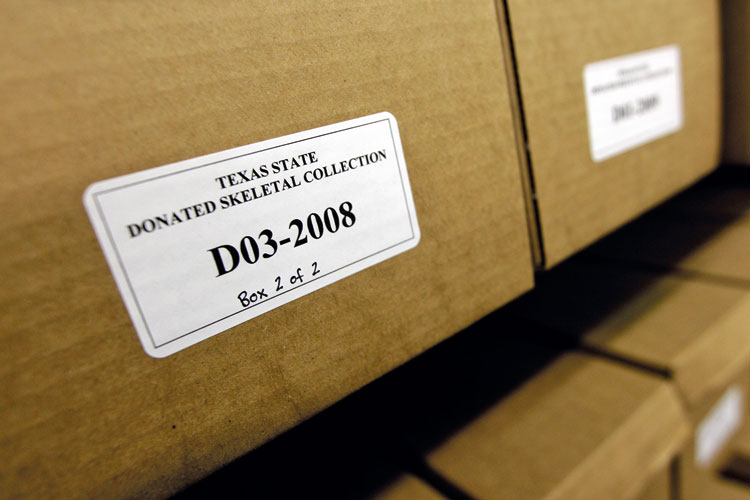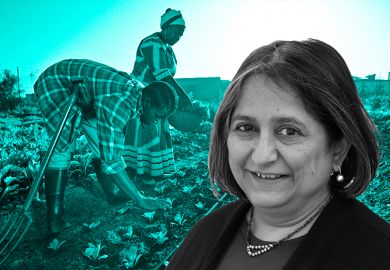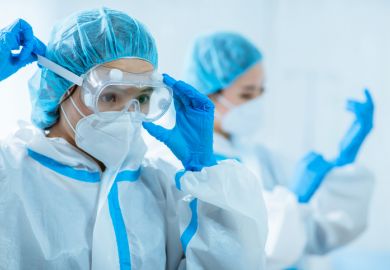If you phone the Forensic Anthropology Center at Texas State University (known as “Facts”) when no one is available, the answerphone message begins: “If you need immediate assistance with a donation…”
Many university departments hope that people will give them money, but why, you might wonder, would anyone require “immediate assistance” to do so?
“…Please leave your name, the name of the decedent and your phone number.”
Assuming you are not thrown by the rather euphemistic use of the US legal term “decedent”, the penny should now have dropped. Although Facts is happy to receive financial contributions, the primary “donations” that it is looking for are dead bodies.
The website (which also sells Facts T-shirts) explains that such donations “help advance scientific knowledge in human decomposition, human skeletal variation, and osteological methods used by forensic anthropologists”. And this, in turn, can “assist law enforcement agents and the medicolegal community in their investigations”, notably by helping them to determine time since death or “develop a biological profile (for example, age, sex, ancestry and stature)” that can help to identify a corpse. A striking example of such expertise in action is a project called Operation ID, run by Kate Spradley, associate professor of anthropology at Texas State, which works with the remains of Latin American migrants who were trafficked to near the US-Mexican border and then left to fend for themselves in the appalling heat.
Facts is one of six such facilities in the US, colloquially known as “body farms” (the first outside the US is currently being built by the University of Technology Sydney). The pioneer, the University of Tennessee Anthropological Research Facility, was set up outside Knoxville by anthropologist William Bass in 1981. It appears under a slightly different name in Patricia Cornwell’s 1994 thriller The Body Farm, in which the heroine, forensic scientist Kay Scarpetta, encounters “plastic-lined pits where bodies tethered to cinder blocks were submerged in water. Old rusting cars held foul surprises in their trunks or behind the wheel. A white Cadillac, for example, was being driven by a man’s bare bones. Of course, there were plenty of people on the ground, and they blended so well with their surroundings that I might have missed some of them were it not for a gold tooth glinting or mandibles gaping…Walnuts were all around, but I would not have eaten one of them because death saturated the soil and body fluid streaked the hills.”
Although this passage no doubt includes an element of the thriller writer’s licence to shock, Cornwell certainly has first-hand knowledge of the facility. She contributed a foreword to Bass and Jon Jefferson’s 2004 book Death’s Acre: Inside the Legendary “Body Farm”, which includes a description of an experiment that Bass conducted on Cornwell’s behalf into the marks left by a coin on a decaying corpse.
It is obvious that a better understanding of how bodies decay in particular circumstances, how (and how quickly) they get disfigured by scavengers and what skeletal remains reveal about someone’s weight or lifestyle can provide important information for law enforcement. It is equally obvious that the sights and smells associated with the processes of skin slippage, “bloating” and “marbling” and the damage inflicted by maggots and vultures make for a challenging working environment. So how do staff and students cope? What do local communities make of such facilities? And even if people are keen to do good after their deaths, isn’t it rather odd for them to choose to donate their bodies to the local body farm, rather than the local medical school? Enemies defeated in battle may be left to rot, but isn’t there a universal human need to create rituals around the deaths of loved ones? Isn’t it violating some deep taboo just to dump their bodies in a field, whatever good may come of it?
At parties, says Melissa Connor, director of the Forensic Investigation Research Station (Firs) at Colorado Mesa University, “people generally think [my job] is cool, partly because they don’t understand the reality of dealing with deceased humans and their families”. The popularity of television series featuring forensic scientists, such as CSI: Crime Scene Investigation and Bones, means that “people generally have an understanding of why we do this”; much of the station’s work does indeed involve “training police for their needs if they wish to collect evidence and estimate post-mortem interval”.
Firs is the most recent of the six US facilities to be set up. The original plan to locate it closer to residential areas was rejected amid local concerns about “odour and flies”, but since Connor joined in 2012 the community has been very positive: “How much more supportive can they be than giving us their bodies?” she asks. The facility has received about 30 corpses since it began operating in late 2013, even though its need to take possession of them before they start to decompose means that there is no time for families to hold a traditional memorial service (for which reason Connor suggests “a memorialisation without the body”).

When it comes to students, Connor offers “a fairly organised desensitisation process”.
“I don’t take a freshman out to the body farm and let them see 20 human remains on their first day of college,” she explains. “They take a couple of classes with me, and we are small enough [in number] that I can watch the students and see how they are reacting.” Yet in the case of students studying autopsy procedures, for example, many soon “morph from standing outside the window and watching it from the corner of their eyes to going in and lending a hand”.
Connor cites a particular case of a female student who “doesn’t mind looking, but has a real problem with the smell. We’re finding ways of working on that. We went out [to the body farm] on a nice breezy day and she was fine with that. But when we get relatively fresh and relatively odoriferous cadavers with no breeze, that’s when she says: ‘I think I’m going to go back inside.’ I’ve suggested she can work with archaeologists, where she can put her knowledge of the skeleton to use.”
She has little sympathy for the notion that there is something “unnatural” about the work. “Personally, I think laying a body outside to decay could be considered a hell of a lot more natural than stuffing it full of chemicals and putting it in a box in the ground. We’ve had donors talking about simply allowing their bodies to decay naturally…Others just want to stay on the west slope of Colorado – they like it here.”
Similar themes are taken up by Cheryl Johnston, director of the Forensic Osteology Research Station (Forest) at Western Carolina University, which currently has 10 bodies exposed on the surface and four buried. The latter provide “the right kind of training material” (as opposed to the placenta or bags of chemical used elsewhere) for the institution’s pioneering cadaver dog training courses, which teach the animals to find but not to disturb the corpses.
A further three corpses have been laid out in wood chips for what Johnston calls “research on human composting as an alternative mortuary treatment”. Forest is carrying this out for an organisation called the Urban Death Project, which hopes to develop more environmentally friendly forms of body disposal, using neither the chemicals required for embalming nor the fuel needed for cremation. Eventually, if Johnston’s research goes well, the process may generate “compost material which can be spread on a flower garden or in a park to help bring new life forth”.
She agrees with Connor that the popularity of forensic anthropology among television producers means that the public generally understand Forest’s work and the good that comes of it. Nonetheless, she comes across “a lot of misunderstanding”, so it’s good to have an opportunity to “set people straight. They just think [dealing with dead bodies] is way more gruesome and gory than it really is. Yes, it smells bad and looks kind of horrible for a while, but it’s not blood and guts or dismemberment. There are a lot of things far more graphic. It’s basically just peace, tissue coming apart, dissolution of tissue.”
Facts director Daniel Wescott is told “all the time” that “I’m glad it’s your job and not mine”. But, from his point of view, the smell – which he is “always” asked about – “is not nearly as bad as people think it is. It’s only when [cadavers] are in bloat that they smell.”
He says the centre gets about 70 donated bodies a year: “Ideally we would like 100 a year, though it’s not as if we do any kind of advertisement or anything.” Apart from the “green” considerations, other incentives to donate include the costs of traditional funerals and the fact that such facilities, unlike medical schools, may accept bodies on which an autopsy has been performed, or whose organs have been donated.
Facts has about 60 bodies at any one time. Eight or nine are left completely unprotected, since one of the centre’s specialisms is research on avian scavengers, which Wescott describes as “very important for times of death, because the birds can skeletonise a body in less than a day – a lot quicker than people thought before”. Other major projects are looking at how factors such as obesity are “reflected in the microstructure of the bone”; whether drones can detect changes in soil chemistry that might indicate the presence of a corpse; and estimating time since death “especially long term – months or years out, rather than just whether they are in rigor mortis or stuff like that”. The facility is also open to more specific enquiries from the police, such as whether diabetes has any effect on the speed of decomposition.
Like his fellow directors, Wescott is eloquent on the practical value of Facts’ research and doesn’t see it as breaching any taboo or interfering with the mourning process.
“You can hold a funerary ritual with the body unembalmed,” he points out. “I guess you could do anything you wanted to – you’d just have to do it relatively quick.” And, at a later stage, “the families can come and visit the skeletons, which we process and retain so they can be utilised for hundreds of years and hundreds of studies”.
POSTSCRIPT:
Print headline: Bodies of evidence
Register to continue
Why register?
- Registration is free and only takes a moment
- Once registered, you can read 3 articles a month
- Sign up for our newsletter
Subscribe
Or subscribe for unlimited access to:
- Unlimited access to news, views, insights & reviews
- Digital editions
- Digital access to THE’s university and college rankings analysis
Already registered or a current subscriber?




